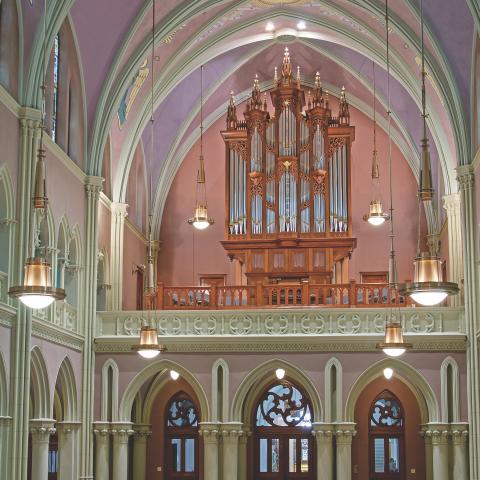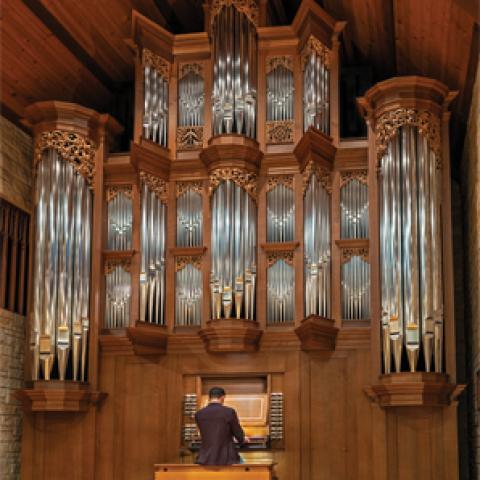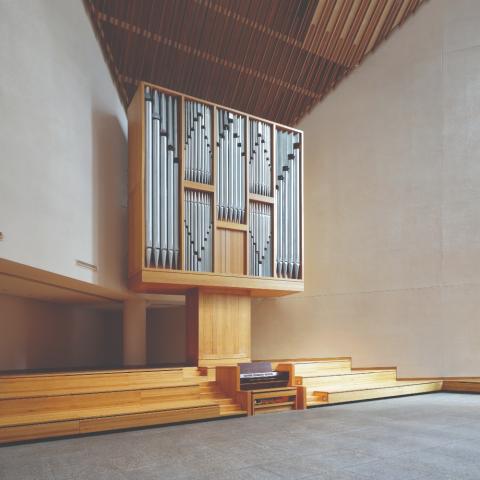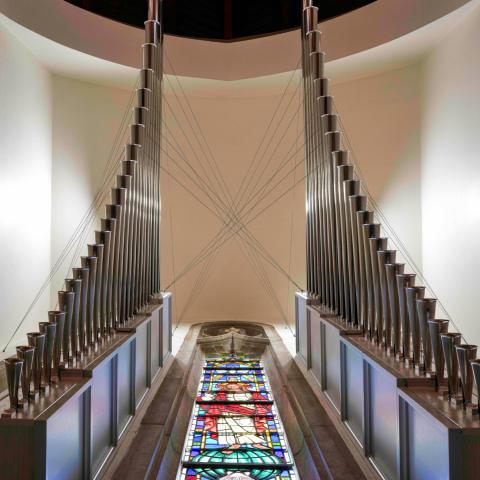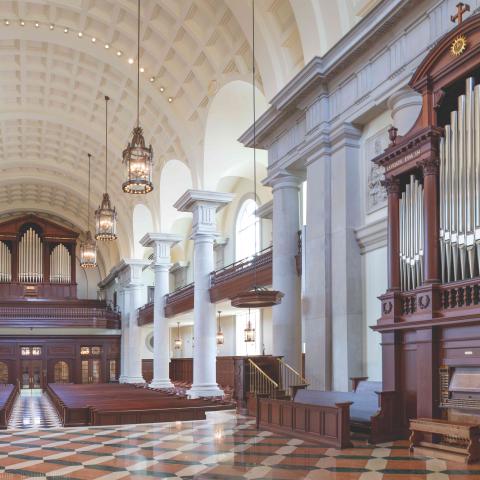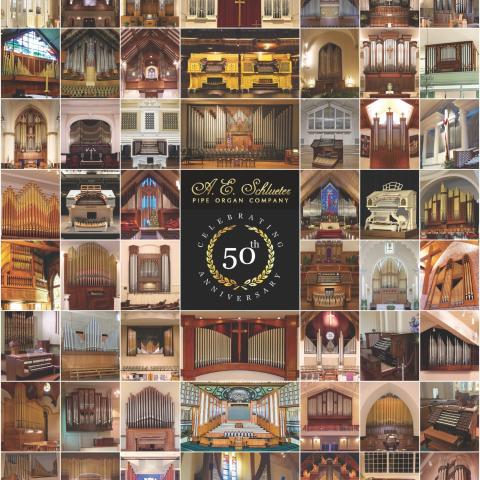Paul Fritts & Company Organ Builders, Tacoma, Washington; Saint Thomas Episcopal Church, Terrace Park, Ohio

From the builder
More than a decade ago the people of Saint Thomas Episcopal Church in Terrace Park, Ohio, began planning for a renovation of their sanctuary. This led to the formation of an organ committee, which then secured the well-organized guidance of consultant Paul Thornock. Their previous organ’s shortcomings, large in number, had become obvious, and there was a desire to explore the numerous possibilities commissioning a new organ encompasses. We were first contacted about an organ project in 2014, and the project came full circle some nine years later with the arrival of the organ and installation at the church on September 10, 2023.
Budgets rarely enable an organ builder to do what they would really like to do in a given situation. This has a positive impact on our work because, among other things, it imposes the discipline of working efficiently without compromising high standards. Proficiency goes hand in hand with finding ways to maximize a budget’s “bang for the buck.” One theme of this project was to have the resources that meet the needs of the program thus pushing the budget higher than possible. We proposed repeating a previously built organ that would fit the church with little compromise, thus saving a great deal of design work. The organs we build are unique to their homes and are precisely engineered throughout with all aspects ideally coordinated for the best outcome. Utilizing an existing concept with minor modifications could save more than a thousand hours of design time. Labor is the leading cost building organs in a workshop where virtually every part of an organ is crafted from raw materials, so this time savings is significant, plus familiarity with the concept by the organbuilding team saves additional time.
Providing space on the windchests for pipes to be added at some future time also reduces the initial budget, but the expense of preparing for these pipes in an organ generally means building all the infrastructure except for the pipes. The downside of this is the uncertainty of when and if these stops will ever be funded. Despite this, the initial contract, signed in 2015, describes a twenty-five-stop instrument with Great, Swell, and Pedal divisions and seven preparations. All the preparations involved expensive reed stops except for one, which was a Mixture of six ranks bringing the organ to a total of thirty-two stops. Reed stops are a good choice for preparations due to their high cost and the fact that they can later be easily accessed at the rear of the windchests.
Throughout this project’s long delay, five other projects were moved ahead in the production schedule and the Saint Thomas people had additional time to fundraise. Over this period of time I made the decision to design an entirely new and unique concept for the organ. We have but one opportunity to push the boundaries of creativity with each project, and a new concept expanded what could be done despite the added cost to us. We always adhere to our contract obligations, and with this decision our ongoing policy of delivering more than promised continues. The decision was met with great enthusiasm by the church, and we moved forward with all of the stop preparations fully funded for a thirty-five-stop, two-manual and pedal organ. The organ contract was signed in 2015, but renovation planning and related fundraising progressed over many years until the actual organ building by our team of eight began early in 2022.
The new design is inspired by the so-called “Wide Hamburg Case,” which provides a good solution for this single-cased organ. Versions of this concept are relatively common throughout the Northern parts of Germany and the Netherlands, and we have experience building these relatively complicated cases. It features three protruding, segmented towers and two pointed towers with large pipes and a series of major-third-arranged treble pipe flats between. This theme is duplicated with a few modifications for the upper center section of the case, behind which stands the swell box.
The appearance appropriately gives a face to the tonal qualities of specific sixteenth- and seventeenth-century European instruments considered to showcase a high point of organ sound. In significant ways, these gorgeous and lasting sound qualities provide inspiration for our work. Despite these lofty goals, what the cooks end up creating is what counts, and this organ meets our goals. All who study the organ must be mindful that it is a workshop’s culture that determines the outcome of any organ, and more specifically, it is the workshop culture during the time of construction that determines the outcome of a specific organ.
At the risk of describing sound quality with words, I will say that the sound of the individual pipes is full, warm, sweet, unforced, and colorful. This combined with quick and subtle speech characteristics provide qualities that are remarkably useful, foremost in terms of individual beauty, but they also enable superior blending with other stops and adapt easily to a wide variety of acoustical environments and musical styles. If we are to achieve these goals, other aspects of the organ must be in place throughout the concept. These include a free-standing case within the space with tightly grouped façade pipes and three-dimensional carvings, compact, customized chest layouts, relatively low wind pressure, pallets (valves) opened by means of a direct mechanical key action, a robust wind system, and more. A three-sided swell box, string stops, an authentic French Symphonic Hautbois, and a modern combination system (combined with the mechanical stop action) broaden the overall concept.
The pipes and their voicing are the most important contributors to the success of an organ. All the metal pipes are made in our workshop from tin-lead sheets of various alloys, exclusively cast on a tightly packed and flat sand bed. The very rapid cooling of the pipe metal on this sand surface (compared to a relatively long cooling period on a cloth-covered stone table) produces metal sheets with a smaller crystalline structure. This has a discernable benefit to the sound and speech of the pipes. Beyond this advantage, the details of the pipe construction and voicing contribute substantially to the final tonal result.
The Saint Thomas case is made of ammonia fumed and oiled, solid white oak. Fuming accelerates the natural darkening of white oak for a rich, stain-free look. We were fortunate to find a supplier who imports from Germany sawn logs that have been kept together after drying. Generally, the wood from one log is similar in color and texture throughout. In this case, one log yielded enough material to build the entire case front, guaranteeing a remarkable consistency of appearance throughout. The carvings are also of white oak and were carved by Christiane Sandler.
I am grateful to work with a great team of craftsmen and contributors here at the Fritts workshop: Greg Bahnsen, Zane Boothby, Rain Daley, Raphi Giangiulio, Erik McLeod, Andreas Schonger, Bruce Shull, Ben Wooley, and our bookkeeper, Marlon Ventura. All of us share a deep appreciation for the continued support and enthusiasm of the Saint Thomas Episcopal Church community.
—Paul Fritts
From the associate director of music and organist
The decade-long journey that led to the completion of the new Paul Fritts & Company organ at Saint Thomas Episcopal Church in Terrace Park, Ohio, likely echoes most of the stories we read in these journals about acquiring new instruments. Though I could rightfully boast about the excellence of our committee, our superb consultant, and the absolute joy it was to traverse the path together that led to this marvelous accomplishment, the immediate impact of this organ in the life of Saint Thomas and its role in realizing the vision of the role of music and beauty at this church is much more impactful.
The mission of music at Saint Thomas is to change lives by bringing people closer to our Heavenly Father through the divine gift of music both in and beyond our church. We seek to do this through inspiring traditional worship, enriching the artistic life of our community through the supporting of the offering of sacred music at the highest and most profound levels, and sharing the profundity and beauty of our worship tradition to new generations. We seek to fulfill this mission and vision with all the diligence we can muster. Our fully capable Parish Choir (comprising mostly volunteers, with just a few singers invited to lead our sections) and our monthly series of Bach Vespers, in which we seek to present the cantatas of Bach in their original context as a part of worship, earnestly and capably endeavor to fulfill our mission.
To fulfill the mission of music at Saint Thomas, church leadership and the organ committee sought that the result of our renovated chancel and new organ would be of utmost beauty, for “beauty is an ultimate value—something that we pursue for its own sake, and for the pursuit of which no further reason need be given. Beauty should therefore be compared to truth and goodness, one member of a trio of ultimate values.”1 We sought that this beauty would, both aurally and visually, serve the mission of our music program.
We feel that we have succeeded beyond our wildest imaginations. Paul Fritts & Company Opus 43 is the realization of utmost aural and visual beauty. I cannot walk into the church without my eyes drawn heavenward as they fall on this magnificent instrument. All too quickly, as I go to practice and utilize this organ in its intended role of enriching life and drawing people closer to our Heavenly Father through the power of the highest quality of sacred music, it is evident that this instrument some would argue is built rigidly in one style of organbuilding is absolutely worthy of magnificently presenting all of the literature in the realization of the mission of music at Saint Thomas.
In a time where we forsake timeless traditions and philosophies that have guided us to where we are today, it is our hope and desire that the time-honored tradition of presenting music of the highest quality will edify, inspire, and uplift all who come to partake of the music and worship offerings at Saint Thomas, that the excellence we strive for will find a home in the hearts of those who enter our doors and provide guidance, comfort, and cheer, leading to a greater relationship with our Heavenly Father.
This magnificent organ is the perfect vehicle for us as we seek to perpetuate this goal. We warmly invite and welcome all who wish to come and see!
—Jason M. Gunnell
The Rev. Darren R. S. Elin, rector
Dr. Carlton Monroe, director of music
Dr. Jason M. Gunnell, associate director of music and organist
The Saint Thomas Organ Committee
Vern Thomas, chairman
The Rev. Daniel Grossoehme
Jason M. Gunnell
Mary Malotke
Gerry Michaud
Carlton Monroe
Brian Rau
The Rev. Robert E. Reynolds
Paul Thornock, consultant
1. Roger Scruton, Beauty: A Very Short Introduction (Oxford: Oxford University Press, 2011), 2.
GREAT (Manual I)
16′ Bourdon
8′ Principal
8′ Rohrflöte
4′ Octave
4′ Spitzflöte
3′ Quint
2′ Octave
1-3⁄5′ Tierce
Mixture IV–VI
8′ Trompet
8′ Dulcian
SWELL (Manual II)
8′ Praestant (façade)
8′ Principal
8′ Gedeckt
8′ Violdigamba
8′ Voix celeste
4′ Octave
4′ Rohrflöte
3′ Nasat
2′ Octave
2′ Blockflöte
1-3⁄5′ Terz
1-1⁄3′ Larigot
Mixture IV–V
16′ Fagott
8′ Trompet
8′ Hautbois
PEDAL
16′ Subbaß
8′ Principal
8′ Bourdon (ext Subbaß)
4′ Octave
2′ Nachthorn
16′ Posaune
8′ Trompet
4′ Trompet
Couplers
Swell to Great
Great to Pedal
Swell to Pedal
Compass
Manual: 58 notes
Pedal: 30 notes
Other
Polished tin front pipes
Solid wood casework with carved pipe shades
Suspended, direct mechanical key action
Mechanical stop action
Multi-level combination system with divisionals, generals, and sequencer
Tremulant
Wind Stabilizer
Zimbelstern
35 stops, 43 ranks, 2,223 pipes

